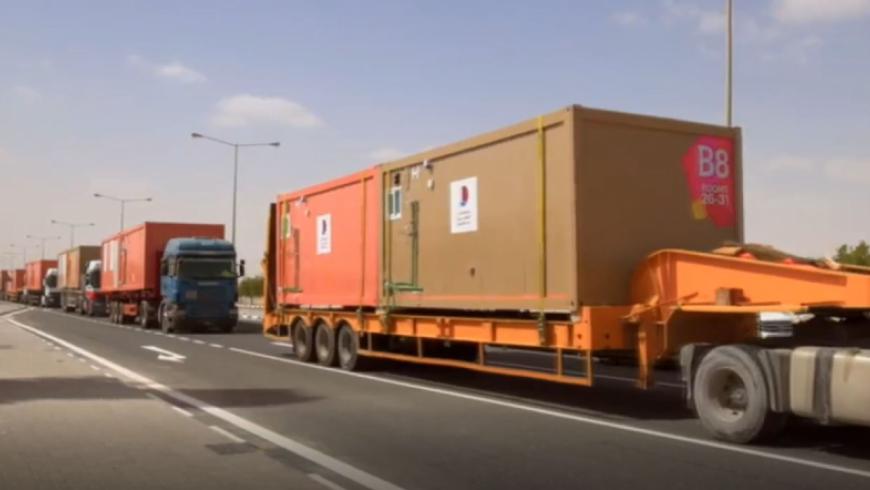Approximately one week after the earthquake that hit southern Turkey and northern Syria, official and popular financial aid from the six Arab Gulf countries, including donations, have totalled around $385 million, as reported by Anadolu Agency.
An Anadolu Agency analysis of official statements and announcements reveals that numerous campaigns in the Gulf countries received a significant turnout, while others did not disclose details about their activity. The breakdown is as follows:
Saudi Arabia
The King Salman Relief Center launched the “Popular Campaign for the Relief of Earthquake Victims in Syria and Turkey”, following a directive from King Salman bin Abdulaziz and Crown Prince Mohammed bin Salman, without specifying a date for its completion.
According to the government’s Sahem platform, the number of participants in the campaign rose to one million and 545 thousand, and 729 donors on its seventh day, with an initial toll of more than 344 million and 849 thousand and 604 riyals ($ 89.2 million) as of 11:34 (GMT) on Monday evening.
UAE
After the earthquake, Sheikh Mohammed bin Zayed al-Nahyan, ordered $100 million for relief to those affected by the earthquake, equally distributed between Turkey and Syria.
Sheikh Mohammed bin Rashid Al Maktoum, Vice President of the UAE, also directed the conduct of urgent humanitarian aid to the Syrian people worth 50 million dirhams ($ 13.6 million).
Sheikha Fatima bint Mubarak, President of the Supreme Council for Motherhood and Childhood, directed the donation of 50 million dirhams ($13.6 million) to support the “Jusoor Al-Khair” campaign.
Kuwait
The Kuwaiti Cabinet announced a donation of $ 30 million to support Turkey and Syria (equally) to alleviate the human suffering of those affected by the earthquake.
Ministries, including the Ministry of Social Affairs, launched a one-day donation campaign entitled “Kuwait is by your side” to relieve those affected by the earthquakes in Turkey and Syria.
In its final tally, the campaign resulted in more than 20.7 million dinars ($67.7 million) with the participation of “more than 129,000 donors.”
Qatar prepares mobile homes
On its first day, donations to the Sanad & Anoun campaign amounted to QR168 million ($46 million), including QR50 million ($14 million) from Qatar’s Emir Sheikh Tamim bin Hamad al-Thani.
On February 8th, the Qatar Red Crescent announced the allocation of one million dollars from the Disaster Response Fund to carry out urgent relief interventions for those affected by the earthquake in Turkey and northern Syria.
According to a statement by the Qatar Red Crescent, it has launched a humanitarian campaign to collect donations worth $10 million to expand the scope of relief intervention for those affected.
Mobile homes
The Director General of the Qatar Fund for Development, Khalifa bin Jassim al-Kuwari said on Tuesday that a ship loaded with mobile homes is preparing to leave Hamad Port to deliver these homes to those affected by the earthquake in Turkey and Syria.
Kuwari said in remarks quoted by Anadolu Agency that these houses, although small, contain all facilities, including toilets, kitchen equipment and a living room.
On Monday, new Qatari aid convoys entered the Bab al-Hawa border crossing with Turkey to northwestern Syria to provide relief to those affected by the earthquake that struck the region at dawn last Monday.
The correspondent of Syria TV at the Bab al-Hawa crossing said that the convoy is a continuation of a series of humanitarian aid convoys that previously entered northwestern Syria.
The convoy contains relief materials and medical supplies and is accompanied by Qatar Red Crescent cadres, he said. He pointed out that the process of distributing aid will be carried out directly through the Qatar Red Crescent and Qatar Charity.
The team accompanying the convoy confirmed that Qatar would continue to provide humanitarian assistance to those affected by the earthquake in northwestern Syria as long as needed.
This article was translated and edited by The Syrian Observer. The Syrian Observer has not verified the content of this story. Responsibility for the information and views set out in this article lies entirely with the author.


